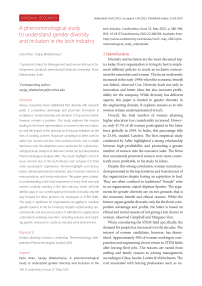A phenomenological study to understand gender diversity and inclusion in the tech industry
Автор: Khan F., Bhattacharya S.
Журнал: Cardiometry @cardiometry
Рубрика: Original research
Статья в выпуске: 22, 2022 года.
Бесплатный доступ
Various researches have established that diversity with inclusion yields a competitive advantage and promotes innovation in workplaces. Gender diversity and retention of top women talent, however, remains a problem. This study explored the reasons leading to the lower representation of women in the tech industry and the impact of the diversity and inclusion initiatives on the lives of working women. Purposive sampling has been used to select four women and two men working in tech, and in-depth interviews over the telephone were conducted for a phenomenological study. Analysis of data was carried out by Interpretative Phenomenological Analysis (IPA). The results highlight common issues women face in the tech industry and compare it to their male counterparts’ experiences. Women highlight unconscious biases, internal and external obstacles, lack of women mentors at senior positions, and family restrictions. This paper gives a deeper understanding of the lived experience of entry-level men and women currently working in the tech industry, which will help identify gaps in our current approach towards inclusivity and the way forward for these practices for employees in STEM fields. The study is significant for organizations struggling to maintain gender balance in the tech industry despite implementing several diversity and inclusion practices. It will help the organizations understand a relatively new term, including inclusion and adopting specific measures to create an inclusive work environment.
Gender diversity, inclusion, leadership, phenomenology, interpretative phenomenological analysis (ipa)
Короткий адрес: https://sciup.org/148324620
IDR: 148324620 | DOI: 10.18137/cardiometry.2022.22.386394
Список литературы A phenomenological study to understand gender diversity and inclusion in the tech industry
- R.D. Adler, Women in the executive suite correlate to high profits. Harvard Business Review, 79, 3, 30-32, (2001).
- N. J. Adler, Women leaders: Shaping history in the 21st century. Women as global leaders, 21-50, (2015).
- V.M. Bentz, J.J. Shapiro, Mindful enquiry in social research, (1998).
- E. Bolton, The science behind the implicit bias. AAUW Outlook, 110, 2, 19-21, (2016).
- C.O. Boyd, Phenomenology the method. PL Munhall (Ed.), Nursing research: A qualitative perspective, 3, 93-122, (2001).
- H.I. Brink, Validity and reliability in qualitative research. Curationis, 16, 2, 35-38, (1993).
- E.F. Cabrera, Opting out and opting in: understanding the complexities of women’s career transitions. Career Development International, (2007).
- T. Cox, Jr. Cultural diversity in organizations, (1993).
- J.W. Cresswell, Qualitative inquiry and research design: Choosing among five traditions, (1998).
- J.W. Creswell, D.L. Miller, Determining validity in qualitative inquiry. Theory into Practice, 39, 3, 124-130, (2000).
- N.K. Denzin, The research act: A theoretical introduction to sociological methods. McGraw-Hill, (1978).
- B.M. Ferdman, M.N. Davidson, Some learningabout inclusion: continuing the dialogue, (2004).
- C.M. Fiol, M.G. Pratt, E.J. O’Connor, Managing intractable identity conflicts. Academy of Management Review, 34, 1, 32-55, (2009).
- N. Golafshani, Understanding reliability and validity in qualitative research. The qualitative report, 8, 4, 597-607, (2003).
- C. Hakim, Work-lifestyle Choices in the 21st Century: Preference theory, (2000).
- J.M. Hoobler, G. Lemmon, S.J. Wayne, Women’s underrepresentation in upper management. Organizational Dynamics, 3, 40, 151-156, (2011).
- R.H. Hycner, Some guidelines for the phenomenological analysis of interview data. Human studies, 8, 3, 279-303, (1985).
- H. Ibarra, R. Ely, D. Kolb, Women rising: The unseen barriers. Harvard business review, 91, 9, 60-66, (2013).
- D. Kruger, An Introduction to Phenomenological Psychology, (1988).
- L.H. Nishii, The benefits of climate for inclusionfor gender-diverse groups. Academy of Management Journal, 56, 6, 1754-1774, (2013).
- G.A. Office, Women’s earnings: Work patterns partially explain the difference between men’s and women’s earnings. The US Government Printing Office. Washington, DC, (2003).
- M. Sabharwal, Is diversity management sufficient?Organizational inclusion to further performance. Public Personnel Management, 43, 2, 197-217, (2014).
- J.A. Smith, P. Flowers, M. Larkin, Interpretive phenomenological analysis: Theory, method, and research. London: Sage, (2009).
- J.A. Smith, M. Osborn, Interpretative Phenomenological Analysis. Interpretive phenomenological analysis: Theory, method, and research. Sage, 53-80, (2009).
- T.A. Schwandt, Qualitative inquiry: A dictionary of terms. Thousand Oaks, CA: Sage, (1997).
- P. Tharenou, Managerial career advancement. International review of industrial and organizational psychology. Wiley, 39-93, (1998).
- P. Tharenou, Gender differences in advancing to the top. International Journal of Management Reviews, 1, 2, 111-132, (1999).
- C. Welman, F. Kruger, Research methodology for the business & administrative sciences. Oxford University Press, (2001).
- M.F. Winters, From diversity to inclusion: An inclusion equation. Diversity at work: The practice of inclusion, 205-228, (2014).
- S.L. Yvonna, E. Guba, Naturalistic inquiry. Beverly Hills, Calif: Beverly Hills, Calif: Sage Publications, (1985).


